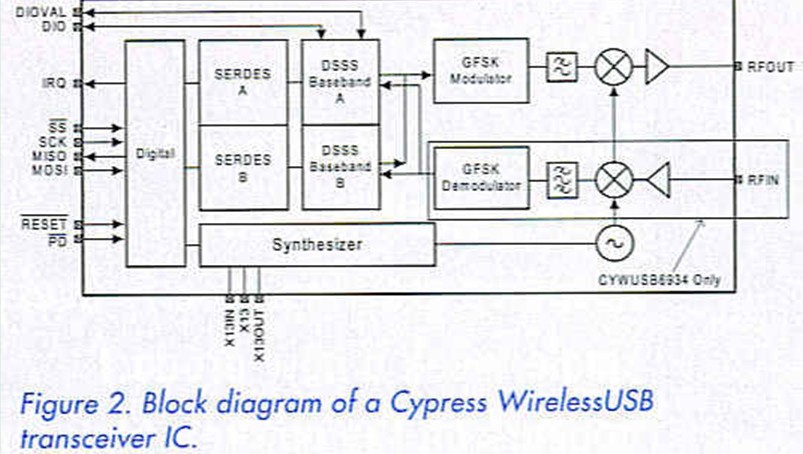

Project Solutions
Wireless USB (2)
Published:2011/7/31 20:42:00 Author:Phyllis From:SeekIC
By Thomas Biel
The Cypress wireless USB family is already in production (since 2003). It uses the 2.4-GHz band, which is available for use without licensing in most countries, while the frequency range preferred by Intel and the MBOA (3.1-10.6 GHz) can be expected to encounter problems with licensing, as it is often used for military purposes in Europe.
Cypress offers a variety of ICs and development kits for users of the WirelessUSB family. At least two units communicating wirelessly with each other are always required for product development. The basic architecture of the IC is shown in Figure 2, using the CYWUSB6934 as an example. A developer’s kit is available for this type and several other types. Strictly speaking, each of the ICs in the CYWUSB69xx family is just an integrated RF data transmitter or transmitter/receiver (transceiver) with an SPI interface, which makes it a sort of SPI/RF interface (SP1-RF bridge). The CYWUSB6934 is a transceiver of this sort with an SPI interface. The only difference between the CYWUSB6932 transmitter IC and the CYWUSB6934 transceiver IC is that the receiver portion with the RF input (RFIN), shown outlined in Figure 2, is omitted in the transmitter IC. The CYWUSB6932 is thus suitable for applications such as a wireless mouse (Figure 3), where it is only necessary to transmit data and the receiver channel is unnecessary. Figure 4 shows a typical block diagram of the circuit at the USB host end (PC end). In this case it is naturally necessary to have a receiver channel, which is provided here by the CYWUSB6934 acting as a WUSB transceiver for bi-directional communication. The second IC in this circuit is a Cypress enCoRe USB controller, which provides the USB link to the PC. This combination works without any special driver and utilises the Microsoft USB HID class. It supports up to six peripheral devices and offers several different error correction methods (FEC, CRC and ARQ), as well as 128-bit encryption. The circuit does not require any external chokes, and the antenna is implemented in the transceiver IC. The ICs comply with the USB power saving standards, and all ICs in the Cypress WirelessUSB family are optimised for operation using disposable or rechargeable batteries (2.4-3.6 V). 


During this year, Atmel will become the second IC manufacturer to produce and supply WirelessUSB™ ICs. A corresponding licensing agreement with Cypress was announced in late June. WirelessUSB is also being supported by OEM manufacturer Unigen, which started producing low-cost modules using Cypress WirelessUSB components in June. The first deliverable product is a transceiver module called ’Juno LPA’ (Figure 5). The Juno LPA module supports separate transmit and receive antennas and has a supplementary RF output stage for an increased range of more than 1000 m.

Reprinted Url Of This Article: http://www.seekic.com/blog/project_solutions/2011/07/31/Wireless_USB__(2).html
Print this Page | Comments | Reading(865)
Article Categories
New published articles
· Imagination works with TSMC to develop FinFET process
Author:Ecco Reading(30207)
· XMOS pushes event-driven MCUs with lower price
Author:Ecco Reading(3463)
· Intel brings upgraded 32-nm SoC for smartphones
Author:Ecco Reading(3183)
· Micron pushes TLC 128-Gbit NAND flash
Author:Ecco Reading(3663)
· Intel will stop supplying desktop motherboards
Author:Ecco Reading(5234)
· Processor market was expected to regain strength in 2013
Author:Ecco Reading(3249)
· It was reported that TSMC sales fall steeply
Author:Ecco Reading(3391)
· Cisco, NXP work with auto wireless startup
Author:Ecco Reading(3531)
· Micron was impacted by manufacturing glitch
Author:Ecco Reading(3937)
· China can make 22-nm transistor by themselves
Author:Ecco Reading(3709)
· Chip market rebound is coming, according to survey
Author:Ecco Reading(3678)
· Sony, Toshiba will spend more on chips, iSuppli reports
Author:Ecco Reading(3715)
· Qualcomm becomes the 13th company to join NFC Forum board
Author:Ecco Reading(6029)
· TSMC increases building work for FinFET fab
Author:Ecco Reading(3694)
· TI plans to cut 1,700 jobs in OMAP shift
Author:Ecco Reading(4480)